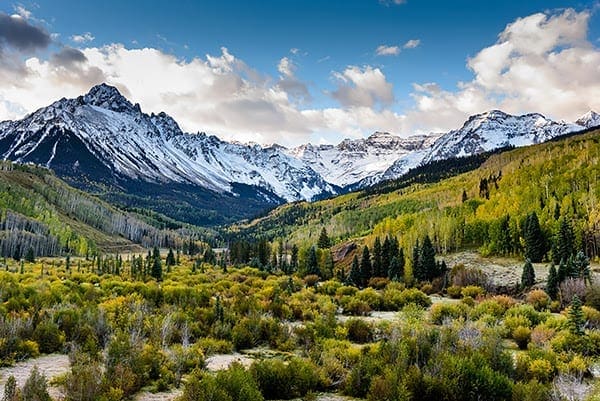New initiative capitalizes on shared-stewardship opportunities in Colorado

EDGEFIELD, S.C. — A new initiative is hoping to increase the effectiveness of projects aimed at reducing the risk of catastrophic wildfire to communities, enhancing recreation, and improving water, wildlife and forest conservation in the Rocky Mountains.
Co-convened by the USDA Forest Service’s Rocky Mountain Region and the National Wild Turkey Federation, the Rocky Mountain Restoration Initiative is uniting diverse private and public organizations from across Colorado in the spirit of the USDA’s Shared Stewardship Strategy, focusing on collaboration with multiple partners to address large-scale conservation and forest management needs across public and private lands.
“We know forest management benefits numerous wildlife species, including wild turkeys,” said Tom Spezze, national director of conservation partnerships with the National Wild Turkey Federation. “There is so much great work already happening across Colorado, and if we look across boundaries, pouring our collective efforts into focused project areas, we can have a larger and more lasting impact for future generations.”
Since summer, the partners have been exploring areas where they can work together to develop a mutual vision and pool resources to make transformational differences in protecting the things Coloradans value most—wildlife, forests, water, recreation and communities.
“The goal is to make real changes to forests and communities so that if a wildfire occurs, it doesn’t put the community out of business for a season, impact the quality of drinking water for a decade nor permanently change the aesthetic character of a favorite trail system,” said Acting Regional Forester Jennifer Eberlien of the Forest Service’s Rocky Mountain Region.
To showcase this innovative shared-stewardship approach, the initiative engaged more than 40 federal, state, local, private and nonprofit partners from across Colorado. These partners chose three initial priority areas—the southwest, the central Front Range, and the I-70 corridor—and convened stakeholders in these priority areas, sharing the concept of the initiative.
The initiative then invited organizations from these priority areas to team up to propose projects where a collective investment in time, talent and resources across land-ownership boundaries could make a significant change to the ability of a community and its surrounding environment to withstand the impact of an unplanned fire. Projects could simultaneously address multiple goals in a given area: restore forests, enhance recreation opportunities, protect waterways, and improve wildlife habitat.
“This is a diverse group of stakeholders, who all have different interests, sitting down at the table, rolling out a map with private, state and federal lands all intermixed, and asking, ‘What should we do?’” Eberlien said.
“It’s the partnership driving the proposal development, evaluation and selection process,” Spezze added. “The partnership will decide where it is best to invest time, energy and funding. When the time comes, the partners will roll up our sleeves to help get the work done.”
While Rocky Mountain Restoration Initiative projects will receive some Forest Service money, the primary goals focus on bringing more attention, resources and leveraged funding to the selected project areas.
The ultimate vision is that the initiative showcases an innovative way to implement shared stewardship, serving as inspiration for more projects that address multiple values — including wildlife, forests, water, recreation and communities — across all lands in Colorado and the West.
The first project selections will be announced toward the end of the year.
About Rocky Mountain Restoration Initiative
The Rocky Mountain Restoration Initiative is a new and evolving partnership seeking to build a broad collaborative foundation working to create healthier forests, watersheds and communities in the Rocky Mountains. Convened in May 2019, the new initiative builds upon a long and robust partnership between the National Wild Turkey Federation and the Forest Service, who have been working together for more than 30 years on forest stewardship and wildlife conservation. The Rocky Mountain Restoration Initiative is comprised of representatives from federal, state, private and nonprofit organizations.
These partners include: National Wild Turkey Federation, USDA Forest Service, Colorado Department of Natural Resources, Colorado Timber Industry Association, The Nature Conservancy, Outdoor Recreation Industry Office, Colorado State Forest Service, Colorado Department of Fire Prevention and Control, National Fish and Wildlife Foundation, Club 20, Rocky Mountain Research Station, Denver Water, National Forest Foundation, Colorado Water Conservation Board, Vail Resorts, Intermountain Forest Association, Great Outdoors Colorado, USDA Natural Resources Conservation Service, Colorado Oil and Gas Association, Colorado Parks and Wildlife, Bureau of Land Management, Neiman Enterprises, Colorado Counties Inc., Arkansas Basin Roundtable, Colorado Springs Utilities, Mule Deer Foundation, Southwest Basins Roundtable, Xcel Energy, Montrose Forest Products, AF Group, Inter Basin Compact Committee, Gates Family Foundation, American Forest Foundation, and Blue Forest Conservation.
About the National Wild Turkey Federation
When the National Wild Turkey Federation was founded in 1973, there were about 1.3 million wild turkeys in North America. After decades of work, that number hit a historic high of almost 7 million turkeys. To succeed, the NWTF stood behind science-based conservation and hunters’ rights. The NWTF Save the Habitat. Save the Hunt. initiative is a charge that mobilizes science, fundraising and devoted volunteers to conserve enhance more than 4 million acres of essential wildlife habitat, recruit at least 1.5 million hunters and open access to 500,000 acres for hunting. For more information, visit NWTF.org.
